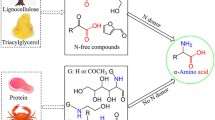Abstract
In this mini-review, an overview about various developed strategies for accessing industrially relevant primary n-alkyl amines via reductive amination by means of amine dehydrogenases as well as transaminases is given. Such transformations were combined with in situ cofactor recycling methodologies avoiding the need for addition of external stoichiometric amounts of organic co-substrates. These methods comprise the application of natural photosynthesis with algae when using carbonyl compounds as substrates as well as the utilization of alcohols as substrates in combination with self-sufficient biocatalytic systems. As such a feature is of utmost importance for large-scale biotransformations in the field of bulk chemicals, which represent high-volume but low-price chemicals, the achievements open up a perspective for biocatalysis also in the area of commodity chemicals. Besides approaches to n-alkyl amines and cyclohexylamine, recently also biocatalytic cascades towards n-alkyl amines bearing functionalities in the ω-position such as a carboxylic acid ester or amino group were reported. It is noteworthy that for ω-aminolauric acid, such a process has already been demonstrated on pilot plant scale.











Similar content being viewed by others
References
Abrahamson MJ, Vázquez-Figueroa E, Woodall NB, Moore JC, Bommarius AS (2012) Development of an amine dehydrogenase for synthesis of chiral amines. Angew Chem Int Ed 51:3969–3972
Abrahamson MJ, Wong JW, Bommarius AS (2013) The evolution of an amine dehydrogenase biocatalyst for the asymmetric production of chiral amines. Adv Synth Catal 355:1780–1786
Asano Y (2002) Overview of screening for new microbial catalysts and their uses in organic synthesis—selection and optimization of biocatalysts. J Biotechnol 94:65–72
Asano Y, Kaul P (2012) Hydrolysis and reverse hydrolysis: selective nitrile hydrolysis using nitrile hydratase and nitrilase. In: Carreira EM, Yamamoto H (eds) Comprehensive chirality, vol 7. Elsevier, Amsterdam, pp 122–142
Chen FF, Liu YY, Zheng GW, Xu JH (2015) Asymmetric Amination of Secondary Alcohols by using a Redox‐Neutral Two‐Enzyme Cascade. ChemCatChem 7:3838–3841.
Drauz K, Gröger H, May O (eds) (2012) Enzyme catalysis in organic synthesis, vol 1–3, 3rd edn. Wiley-VCH, Weinheim
Evonik Industries AG (2013) An alternative raw material for polyamide 12: Evonik is operating a pilot plant for bio-based ω-amino lauric acid. Press Release, July 30
Gorak M, Zymanczyk-Duda E (2015) Application of cyanobacteria for chiral phosphonate synthesis. Green Chem 17:4570–4578
Gröger H, Asano Y, Bornscheuer UT, Ogawa J (2012) Development of biocatalytic processes in Japan and Germany: from research synergies to industrial applications. Chem Asian J 7:1138–1153
Guo F, Berglund P (2017) Transaminase biocatalysis: optimization and application. Green Chem 19:333–360
Hayes KS (2001) Industrial processes for manufacturing amines. Appl Catal A Gen 221:187–195
Julsing MK, Schrewe M, Cornelissen S, Hermann I, Schmid A, Bühler B (2012) Outer membrane protein AlkL boosts biocatalytic oxyfunctionalization of hydrophobic substrates in Escherichia coli. Appl Environ Microbiol 78:5724–5733
Klatte S, Wendisch VF (2014) Redox self-sufficient whole cell biotransformation for amination of alcohols. Bioorg Med Chem 22:5578–5585
Klatte S, Wendisch VF (2015) Role of L-alanine for redox self-sufficient amination of alcohols. Microb Cell Factories 14:9. https://doi.org/10.1186/s12934-014-0189-x
Köninger K, Gomez Baraibar A, Mugge C, Paul CE, Hollmann F, Nowaczyk MM, Kourist R (2016) Recombinant cyanobacteria for the asymmetric reduction of C=C bonds fueled by the biocatalytic oxidation of water. Angew Chem Int Ed 55:5582–5585
Liese A, Seelbach K, Wandrey C (2006) Industrial biotransformations, 2nd edn. Wiley-VCH, Weinheim
Löwe J, Ingram AA, Gröger H (2018a) Enantioselective synthesis of amines via reductive amination with a dehydrogenase mutant from Exigobacterium sibiricum: substrate scope, co-solvent tolerance and biocatalyst immobilization. Bioorg Med Chem 26:1387–1392
Löwe J, Siewert A, Scholpp AC, Wobbe L, Gröger H (2018b) Providing reducing power by microalgal photosynthesis: a novel perspective towards sustainable biocatalytic production of bulk chemicals exemplified for aliphatic amines. Sci Rep 8:10436. https://doi.org/10.1038/s41598-018-28755-6
Mutti FG, Knaus T, Scrutton NS, Breuer M, Turner NJ (2015) Conversion of alcohols to enantiopure amines through dual-enzyme hydrogen-borrowing cascades. Science 349:1525–1529
Nakamura K, Yamanaka R (2002) Light mediated cofactor recycling system in biocatalytic asymmetric reduction of ketone. Chem Commun 16:1782–1783
Oenbrink G, Schiffer T (2009) Cyclododecanol, cyclododecanone, and laurolactam. In: Ullmann’s encyclopedia of industrial chemistry, 6th edn. Electronic release. Wiley-VCH, Weinheim
Roose P, Eller K, Henkes E, Rossbacher R, Höke H (2015) Amines, aliphatic. In: Ullmann’s encyclopedia of industrial chemistry. Wiley-VCH, Weinheim, p 1–55
Sattler JH, Fuchs M, Mutti FG, Grischek B, Engel P, Pfeffer J, Woodley JM, Kroutil K (2014) Introducing an in situ capping strategy in systems biocatalysis to access 6-aminohexanoic acid. Angew Chem Int Ed 53:14153–14157
Savile CK, Janey JM, Mundorff EC, Moore JC, Tam S, Jarvis WR, Colbeck JC, Krebber A, Fleitz FJ, Brands J, Devine PN, Huisman GW, Hughes GJ (2010) Biocatalytic asymmetric synthesis of chiral amines from ketones applied to sitagliptin manufacture. Science 329:305–309
Schaffer S, Haas T (2014) Biocatalytic and fermentative production of α,ω-bifunctional polymer precursors. Org Process Res Dev 18:752–766
Schrewe M, Ladkau N, Bühler B, Schmid A (2013) Direct terminal alkylamino-functionalization via multistep biocatalysis in one recombinant whole-cell catalyst. Adv Synth Catal 355:1693–1697
Schrittwieser JH, Velikogne S, Kroutil K (2015) Biocatalytic imine reduction and reductive amination of ketones. Adv Synth Catal 357:1655–1685
Weissermehl K, Arpe HJ (2010) Industrial organic chemistry, 5th edn. Wiley-VCH, Weinheim
Yamanaka R, Nakamura K, Murakami M, Murakami A (2015) Selective synthesis of cinnamyl alcohol by cyanobacterial photobiocatalysts. Tetrahedron Lett 56:1089–1091
Funding
This study was funded by the Fachagentur Nachwachsende Rohstoffe (FNR) and the German Federal Ministry of Food and Agriculture (BMEL), respectively, within the funding program on the utilization of biorenewables (grant number: 22001716).
Author information
Authors and Affiliations
Corresponding author
Ethics declarations
Conflict of interest
The author declares that he has no conflict of interest.
Ethical approval
This article does not contain any studies with human participants or animals performed by the author.
Rights and permissions
About this article
Cite this article
Gröger, H. Biocatalytic concepts for synthesizing amine bulk chemicals: recent approaches towards linear and cyclic aliphatic primary amines and ω-substituted derivatives thereof. Appl Microbiol Biotechnol 103, 83–95 (2019). https://doi.org/10.1007/s00253-018-9452-0
Received:
Revised:
Accepted:
Published:
Issue Date:
DOI: https://doi.org/10.1007/s00253-018-9452-0




